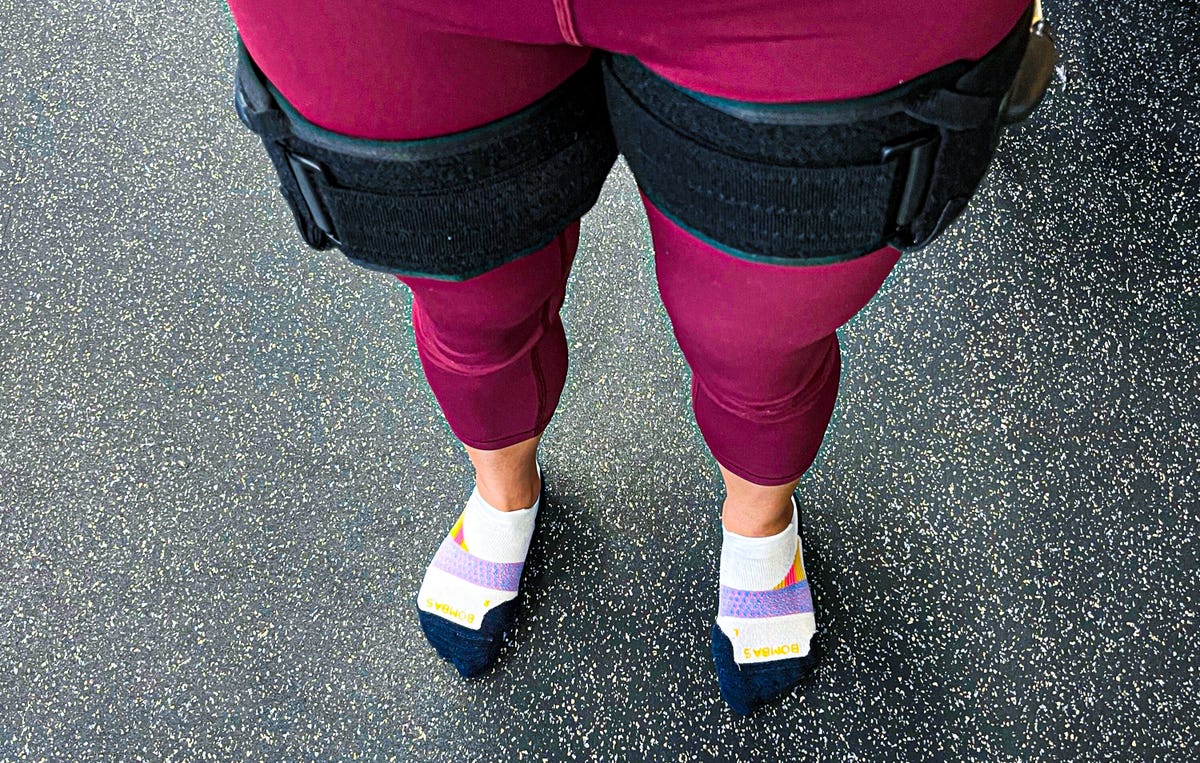Blood flow restriction training (BFR) is a therapy technique that restricts blood flow in your arms or legs during exercise to help with injury rehabilitation, tendinitis, surgery post-op, maintaining strength during recovery and even optimizing performance for competitive athletes. When I was rehabbing a running injury, my physical therapist used BFR training as part of my recovery process. This was the first time I'd used this tool for recovery and it was unlike other techniques I'd tried.
The best way to describe it is this: Imagine having a tourniquet-like cuff tightly wrapped around each of your legs, making simple exercises that much harder. For example, the first time I tried out BFR training, I did bodyweight squats and my quads were much sorer than I expected the next day. It was reminiscent of the soreness you feel a day or two after a heavy volume squat day.
After several rounds of BFR training I noticed my legs felt stronger and more recovered. I was curious to learn more about the method and how it benefits people with different goals, as well as if there are any risk factors associated with it. I talked to Nicholas Rolnick, physical therapist and owner of The Human Performance Mechanic in New York, about the benefits of BFR training and how it works to help just about anyone (regardless of age and background) recover better and perform better in the gym. Read on to learn more about this popular rehab technique.
How does blood flow restriction training work?
To perform BFR training, a specially designed pressure Velcro cuff is placed either on your arm or leg (or both). To determine your personalized pressure, the cuff is connected to a handheld machine that inflates the cuff to the point where the blood flow is blocked in the limb. This is known as arterial or limb occlusion pressure.
Once blood flow is restricted and the cuffs are unplugged from the handheld device, you can perform exercises with little to no weight and still generate a "pump" similar to when you're lifting heavy or performing many reps.
The purpose of blood flow restriction is to provide the same benefits as lifting heavy weights, such as gaining muscle mass and strength, through low-intensity training. As a result of this technique, your muscles work harder to contract and you fatigue sooner than if your blood flow wasn't restricted. This is a good thing because it means you reap the same benefits as a strenuous workout -- but in a less intense way. Therefore, you're less likely to get injured while safely building up strength.
During BFR training, Rolnick explains, you usually perform resistance exercises using four sets for each movement. "For example, you'd do 30 repetitions in the first set followed by three sets of 15 repetitions with a 30- to 60-second rest in between sets," he said. "BFR is usually applied continuously -- meaning the applied pressure is only released once the last repetition of the fourth set is finished."
This was the same format I followed when I used BFR training with resistance band exercises. The band walks, bridges and heel lifts that would normally take double the reps for me to feel fatigued, felt challenging sooner while having my blood flow restricted.

Blood flow restriction training is done by restricting blood flow in your arms or legs using a tourniquet or blood pressure-like cuff wrapped around each of your limbs.
Giselle Castro-Sloboda/ CNETAlthough research on BFR training and its effects on endurance training are not as conclusive as to its benefits with resistance training, if you plan on using BFR while doing aerobics, Rolnick said there are a few ways to perform this. "Usually for aerobic exercise, it's done for 10 to 15 minutes at a low intensity or less than 50% of your VO2max," he explains. VO2max refers to the maximum amount of oxygen you use during intense exercise. If you're interested in measuring your VO2 max, there are several ways to figure that number out, such as a treadmill test or a walk/run test conducted by your doctor.
Benefits of blood flow restriction training
Besides gaining muscle mass and getting stronger, there are plenty of benefits you can reap from BFR training.
"Other potential benefits include pain relief, [improved] cardiovascular capacity and even increasing tendon and bone strength," said Rolnick.
There are other physical therapy modalities like instrument-assisted soft tissue mobilization, kinesiotaping or ultrasound that are used in rehabilitation clinics. However, what makes BFR training unique is that there are many studies that continuously support how effective it is in a variety of groups of people.
"If an exerciser incorporates blood flow restriction into their routine effectively, they can be guaranteed that they are creating a positive change in their body," promises Rolnick.
How long should you do BFR training?
BFR training aims to prevent muscle atrophy (losing muscle mass) and encourage hypertrophy (putting on muscle mass), even when you're unable to lift heavy. "In the rehab setting, BFR is usually applied for six to eight weeks before transitioning to heavier load strength training in those that need to lift heavy for their lifestyle or sport," explains Rolnick. According to research, this treatment has been applied to at-risk populations for extended periods of time ranging from two to six months. Additionally, recent studies done on patients with chronic kidney disease showed that it was safe to do BFR training for up to six months under supervision from a professional.
It's unclear if that same training prescription would apply to unsupervised settings, but generally, an eight- to 12-week BFR resistance and aerobic program is recommended. Regardless of the approach you choose to take, performing a thorough screening process is key to reducing the risk of adverse events.
Who should or shouldn't do BFR training?
BFR training is a universal tool that can help just about anybody. People who have issues carrying or lifting heavier weights due to an injury, surgery, other medical issues, as well as pain in a joint or muscle are good candidates for BFR training. Rolnick recommends getting screened by a BFR-trained provider who can offer a detailed assessment of your medical history, physical activity history and other factors that may be relevant to determine if you're a good candidate for it.
As with any treatment, there may be some risks involved with BFR training. There's a small risk of muscle damage, or of excessive cardiovascular response, such as high blood pressure. Rolnick said that some risks can be prevented by modifying an individual's BFR training prescription as necessary and making sure the provider performing BFR training is qualified.
For example, muscle damage could occur during strenuous BFR training, such as doing multiple sets of exercises until they feel like a struggle to complete. "BFR trained providers understand that this risk is easily managed by avoiding exercising to failure and/or reducing the training loads temporarily to allow the body to adapt and become more resilient," Rolnick elaborates.
BFR training increases blood pressure during an exercise, which is to be expected. However, for people with certain medical issues, a better strategy could involve applying less pressure, deflating the pressure during rest periods and avoiding multijoint exercises.
Rolnick said, "This response may be exacerbated in those with certain medical conditions and warrants consideration of other training approaches and/or modification of the BFR training prescription." He suggests tracking blood pressure levels during the first couple of sessions to ensure your blood pressure does not exceed critical values.
Previously, there were safety concerns around BFR training and blood clots. But Rolnick said there isn't enough evidence to show that BFR training increases the risk of blood clots, and it may instead decrease the risk because of how the body responds to the temporary restriction and release during exercise.
Can BFR Be Done at Home?

Smart Cuffs is one of the brands you can buy for home use.
Giselle Castro-Sloboda/ CNETSimilar to other forms of physical therapy, such as using a TENS machine, you can safely do BFR training at home. But it's important first to go through a screening process with a trained BFR provider so you learn how to get the most out of your sessions.
"When BFR is performed correctly, it is uncomfortable. Therefore, if you are doing BFR and not experiencing discomfort, it is likely not doing much of anything," said Rolnick. He explained that the discomfort is the first signal that a beneficial muscle-building stimulus is occurring. "To promote adaptation, we need to push our physical and mental boundaries beyond that discomfort to expand our capacity and promote benefits in muscle mass, strength and cardiovascular capacity."
If someone is using BFR training for pain relief purposes, experiencing discomfort such as pressure and some numbness at the site during their resistance training sessions is to be expected. Rolnick said BFR training has a powerful effect on pain-relieving responses and you should aim to achieve a discomfort that's challenging yet tolerable, to maximize the therapeutic effect. However, too much pressure or improper use of the BFR straps can lead to a burning or stabbing pain. That's something to look out for because it can be signs of nerve damage.
Takeaway
BFR training is a helpful option to keep in mind if you ever need to heal or get stronger after an injury. From personal experience, it definitely takes some getting used to because it's not everyday that you're doing squats with your blood flow partially cut off. The good thing is that BFR training has been shown to be safe for most individuals, but if you have reservations, consult with your physical therapist or a BFR trained provider. That way you can get a proper assessment and the most out of this type of therapy.
The information contained in this article is for educational and informational purposes only and is not intended as health or medical advice. Always consult a physician or other qualified health provider regarding any questions you may have about a medical condition or health objectives.
"flow" - Google News
July 10, 2022 at 07:00AM
https://ift.tt/mHCS1pc
Recover Faster and Stronger With Blood Flow Restriction Training - CNET
"flow" - Google News
https://ift.tt/AUhRqoF
https://ift.tt/yHbelNV
Bagikan Berita Ini














0 Response to "Recover Faster and Stronger With Blood Flow Restriction Training - CNET"
Post a Comment